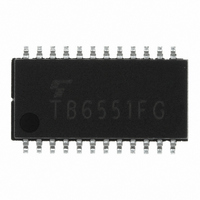TB6551FG(EL,DRY) Toshiba, TB6551FG(EL,DRY) Datasheet

TB6551FG(EL,DRY)
Specifications of TB6551FG(EL,DRY)
Related parts for TB6551FG(EL,DRY)
TB6551FG(EL,DRY) Summary of contents
Page 1
... TOSHIBA Bi-CMOS Integrated Circuit Silicon Monolithic 3-PHASE FULL-WAVE SINE-WAVE PWM BRUSHLESS MOTOR CONTROLLER Features • Sine-wave PWM control • Built-in triangular-wave generator (carrier cycle = f /252 (Hz)) osc • Built-in lead angle control function (0° to 58° steps) • Built-in dead time function (setting 2.6 µs or 3.8 µs) • ...
Page 2
Block Diagram System clock generator X 15 out HU 21 Position detector Regulator CC P-GND 3 S-GND refout Power-on reset RES ...
Page 3
Pin Description Pin No. Symbol Description Positional signal 21 HU input pin U Positional signal 20 HV input pin V Positional signal 19 HW input pin W Rotation direction 18 CW/CCW signal input pin 11 RES Reset-signal-input pin Inputs voltage ...
Page 4
Input/Output Equivalent Circuits Pin Description Symbol Positional signal input pin U HU Positional signal input pin V HV Positional signal input pin W HW Forward/reverse switching input pin CW/CCW L: Forward (CW) H: Reverse (CCW) Reset input RES L: Stops ...
Page 5
Pin Description Symbol Setting dead time input pin L : 3.8 µ Open: 2.6 µs Output logic select signal input pin OS L: Active low H: Active high Over-current protection I dc signal input pin Clock signal ...
Page 6
Pin Description Symbol Reverse-rotation-detection REV signal output pin FG signal output pin FG Turn-on signal output pin U U Turn-on signal output pin V V Turn-on signal output pin W W Turn-on signal output pin X X Turn-on signal output ...
Page 7
Absolute Maximum Ratings Characteristics Supply voltage Input voltage Turn-on signal output current Power Dissipation Operating temperature Storage temperature Note 1: V pin (1) e Note 2: V pin: HU, HV, HW, CW/CCW, RES, OS ...
Page 8
V Electrical Characteristics Characteristics Symbol Circuit Supply current ( (2) Input current ( (2) High Input voltage V in Low Input hysteresis V H ...
Page 9
Functional Description Basic operation On start-up, the motor is driven by the square-wave turn-on signal based on a positional signal. When the positional signal reaches number of rotations higher, the rotor position is inferred from ...
Page 10
Outputting reverse rotation detection signal The direction of motor rotation is detected for every electrical angle of 360°. (The output is high immediately after reset.) The REV terminal increases to a 180° turn-on mode at the time of low. CW/CCW ...
Page 11
Operation Flow Positional signal Position (Hall IC) detector Voltage instruction System clock Oscillator generator (Note) 92% 100% Phase U Counter Phase V Phase matching Phase Sine-wave pattern W (modulation signal) Triangular wave (carrier frequency) Driven by square wave 0.2 V ...
Page 12
The modulation waveform is generated using Hall signals. The modulation waveform is then compared with the triangular wave and a sine-wave PWM signal is generated. The time (electrical angle: 60°) from the rising (or falling) edges of the three Hall ...
Page 13
Timing Charts H u Hall signal H v (input signal FG (output Turn-on signal W when driven by square wave X (output Modulation waveform when driven by sine wave (inside of ...
Page 14
Operating Waveform When Driven by Square Wave Hall signal Output waveform stabilize the bootstrap voltage, the lower outputs (X, Y, and Z) are always turned ...
Page 15
Operating Waveform When Driven by Sine-Wave PWM Generation inside of IC Phase U Phase V Phase W Output waveform Inter-line voltage V UV (U- (V- (W-U) When the motor is ...
Page 16
Example of Application Circuit 14 X System clock in generator 15 X out 21 HU Position detector Regulator (Note 2) P-GND 13 S-GND 24 V ref Power-on reset 11 ...
Page 17
Package Dimensions Weight: 0.33 g (typ.) 17 TB6551F/FG 2007-7-17 ...
Page 18
... Application Circuits The application circuits shown in this document are provided for reference purposes only. Thorough evaluation is required, especially at the mass production design stage. Toshiba does not grant any license to any industrial property rights by providing these examples of application circuits. 5. Test Circuits Components in the test circuits are used only to obtain and confirm the device characteristics. These components and circuits are not guaranteed to prevent malfunction or failure from occurring in the application equipment ...
Page 19
... The information contained herein is presented only as a guide for the applications of our products. No responsibility is assumed by TOSHIBA for any infringements of patents or other rights of the third parties which may result from its use. No license is granted by implication or otherwise under any patents or other rights of TOSHIBA or the third parties ...












